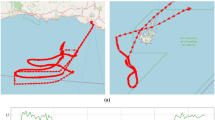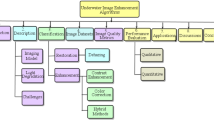Abstract
Object recognition in underwater images becomes a challenging task because of its poor visibility conditions. Marine scientists often prefer automation tools for object recognition as large amount of data is captured everyday with the help of autonomous underwater vehicles. The challenge for classification in such underwater images is the limited color information. An attempt is made to recognize objects in underwater images using an adaptive Gaussian mixture model. The Gaussian mixture model performs accurate object segmentation provided the number of clusters is predefined. Optimization techniques like genetic algorithm, particle swarm optimization and differential evolution were analyzed for initializing the parameter set. Differential evolution is known for its accurate decision making in fewer iterations and proved to be better for initializing the number of clusters for the Gaussian mixture model. Further for object recognition, inner distance shape matching technique was applied. The proposed classification method achieved a maximum accuracy of 99%.




Similar content being viewed by others
References
Chuang, M.-C., Hwang, J.-N., Williams, K.: A feature learning and object recognition framework for underwater fish images. IEEE Trans. Image Process. 25(4), 1862–1872 (2016)
Hou, G.-J., Luan, X., Song, D.-L., Ma, X.-Y.: Underwater man-made object recognition on the basis of color and shape features. J. Coastal Res. 32(5), 1135–1141 (2015)
Rizzini, D.L., Kallasi, F., Oleari, F., Caselli, S.: Investigation of vision-based underwater object detection with multiple datasets. Int. J. Adv. Robot. Syst. 12, 77 (2015). https://doi.org/10.5772/60526
Wang, H.B., Dong, X., Shen, J., Wu, X.W., Chen, Z:. Saliency-based adaptive object extraction for color underwater images. In: Applied Mechanics and Materials, vol. 347, pp. 3964–3970. Trans Tech Publications (2013)
Williams, D.P.: On adaptive underwater object detection. In: IEEE/RSJ International Conference on Intelligent Robots and Systems (2011)
Chen, Z., Zhang, Z., Yang, B., Dai, F., Fan, T., Wang, H.: Underwater object segmentation based on optical features. Sensors 18(1), 196 (2018)
Chen, Z., Zhao, T., Cheng, N., Sun, X., Fu, X.: Towards underwater object recognition based on supervised learning. In: 2018 OCEANS-MTS/IEEE Kobe Techno-Oceans (OTO), pp. 1–4. IEEE (2018)
Jadoun, V.K., Gupta, N., Niazi, K.R., Swarnkar, A.: Dynamically controlled particle swarm optimization for large scale non-convex economic dispatch problems. Wiley, New York (2014)
Das, A., Panda, S.S., Sabut, S.: Detection of liver tumor in CT images using watershed and hidden Markov random field expectation maximization algorithm. In: Mandal J., Dutta P., Mukhopadhyay S. (eds.) Computational Intelligence, Communications, and Business Analytics. CICBA 2017. Communications in Computer and Information Science, vol. 776. Springer, Singapore (2017)
Abdulbaqi, H.S., Jafri, M.Z.M., Omar, A.F., Mutter, K.N., Abood, L.K., Mustafa, I.S.B.: Segmentation and estimation of brain tumor volume in computed tomography scan images using hidden Markov random field expectation maximization algorithm. In: 2015 IEEE Student Conference on Research and Development (SCOReD), pp. 55–60. IEEE (2015)
Su, J., Liu, S., Song, J.: A segmentation method based on HMRF for the aided diagnosis of acute myeloid leukemia. Comput. Methods Progr. Biomed. 152, 115–123 (2017)
Liu, Z., Huang, K., Tan, T.: Foreground object detection using top-down information based on EM framework. IEEE Trans. Image Process. 21(9), 4204–4217 (2012)
Han, X.-F., Jin, J.S., Wang, M.-J., Jiang, W., Gao, L., Xiao, L.-P.: Video fire detection based on Gaussian Mixture Model and multi-color features. SIViP 11(8), 1419–1425 (2017)
Zhang, Y., Brady, M., Smith, S.: Segmentation of brain MR images through a hidden Markov random field model and the expectation-maximization algorithm. IEEE Trans. Med. Imaging 20(1), 45–57 (2001)
Khan, A., ur Rehman, Z., Jaffar, M.A., Ullah, J., Din, A., Ali, A., Ullah, N.: Color image segmentation using genetic algorithm with aggregation-based clustering validity index (CVI). SIViP 13(5), 833–841 (2019)
Chang, D.-X., Zhang, X.-D., Zheng, C.-W.: A genetic algorithm with gene rearrangement for K-means clustering. Pattern Recogn. 42(7), 1210–1222 (2009)
Storn, R., Price, K.: Differential evolution—a simple and efficient heuristic for global optimization over continuous spaces. J. Glob. Optim. 11, 341–359 (1997)
Chandra, A., Chattopadhyay, S.: A novel approach for coefficient quantization of low-pass finite impulse response filter using differential evolution algorithm. SIViP 8(7), 1307–1321 (2014)
Ling, H., Jacobs, D.W.: Shape classification using the inner-distance. IEEE Trans. Pattern Anal. Mach. Intell. 29(2), 286–299 (2007)
Wang, N., Li, Q., Abd El-Latif, A.A., Zhang, T., Niu, X.: Toward accurate localization and high recognition performance for noisy iris images. Multimed. Tools Appl. 71(3), 1411–1430 (2014)
Peng, J., Wang, N., Abd El-Latif A.A, Li, Q., Niu, X.: Finger-vein verification using Gabor filter and sift feature matching. In: 2012 Eighth International Conference on Intelligent Information Hiding and Multimedia Signal Processing, pp. 45–48. IEEE (2012)
Peng, J., Li, Q., Abd El-Latif, A.A., Wang, N., Niu, X.: Finger vein recognition with gabor wavelets and local binary patterns. IEICE Trans. Inf. Syst. 96(8), 1886–1889 (2013)
Zhang, T., Han, Q., Abd El-Latif, A.A., Bai, X., Niu, X.: 2-D cartoon character detection based on scalable-shape context and hough voting. Inf. Technol. J. 12(12), 2342–2349 (2013)
http://fishdb.sinica.edu.tw/. Accessed 27 Aug 2019
http://www.fishbase.org. Accessed 27 Aug 2019
http://fishesofaustralia.net.au. Accessed 27 Aug 2019
http://indiabiodiversity.org. Accessed 27 Aug 2019
http://www.macaubiodiversity.org. Accessed 27 Aug 2019
Jing, H., He, X., Han, Q., Abd El-Latif, A.A., Niu, X.: Saliency detection based on integrated features. Neurocomputing 129, 114–121 (2014)
Maestro-Montojo, J., Salcedo-Sanz, S., Merelo, J.J.: New solver and optimal anticipation strategies design based on evolutionary computation for the game of MasterMind. Evol. Intel. 6(4), 219–228 (2014)
Shi, Y., Eberhart, R.C.: Empirical study of particle swarm optimization. In: Proceedings of the 1999 Congress on Evolutionary Computation, 1999. CEC 99., vol. 3 (2002)
Sherin, B.M., Supriya, M.H., Saseendran Pillai, P.R.: Underwater acoustic target classification system using SVM. Int. J. Electron. Commun. Eng. ISSN (P): 2278-9901, vol. 2, no. 5, pp. 73–80 (2013)
Bai, X., Zhang, T., Wang, C., Abd El-Latif, A.A., Niu, X.: A fully automatic player detection method based on one-class SVM. IEICE Trans. Inf. Syst. 96(2), 387–391 (2013)
Gao, L., Xu, H.: Underwater obstacle classification method for forward-looking sonar of the AUV. Int. Soc. Offshore Polar Eng. (2016)
Chang, R., Wang, Y., Hou, J.,Qiu, S., Nian, R., Bo, H, Lendasse, A.: Underwater object detection with efficient shadow-removal for side scan sonar images. In: OCEANS 2016-Shanghai, pp. 1–5. IEEE (2016)
Son, H.S., Park, J.B., Joo, Y.H.: Fuzzy c-means-based intelligent tracking algorithm for an underwater manoeuvring target. IET Radar Sonar Navig. 8(9), 1042–1050 (2014)
He, Y., Zheng, B., Ding, Y., Yang, H.: Underwater image edge detection based on K-means algorithm. In: Oceans-St. John’s, 2014, pp. 1–4. IEEE (2014)
Yao, H., Duan, Q., Li, D., Wang, J.: An improved K-means clustering algorithm for fish image segmentation. Math. Comput. Model. 58(3), 790–798 (2013)
Lee, D., Kim, G., Kim, D., Myung, H., Choi, H.-T.: Vision-based object detection and tracking for autonomous navigation of underwater robots. Ocean Eng. 48, 59–68 (2012)
Boudhane, M., Nsiri, B.: Underwater image processing method for fish localization and detection in submarine environment. J. Vis. Commun. Image Represent. 39, 226–238 (2016)
Author information
Authors and Affiliations
Corresponding author
Additional information
Publisher's Note
Springer Nature remains neutral with regard to jurisdictional claims in published maps and institutional affiliations.
Rights and permissions
About this article
Cite this article
Kannan, S. Intelligent object recognition in underwater images using evolutionary-based Gaussian mixture model and shape matching. SIViP 14, 877–885 (2020). https://doi.org/10.1007/s11760-019-01619-w
Received:
Revised:
Accepted:
Published:
Issue Date:
DOI: https://doi.org/10.1007/s11760-019-01619-w




